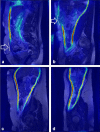A novel diagnostic aid for intra-abdominal adhesion detection in cine-MRI: pilot study and initial diagnostic impressions
- PMID: 28707532
- PMCID: PMC5858811
- DOI: 10.1259/bjr.20170158
A novel diagnostic aid for intra-abdominal adhesion detection in cine-MRI: pilot study and initial diagnostic impressions
Abstract
Objective: A non-invasive diagnostic technique for abdominal adhesions is not currently available. Capture of abdominal motion due to respiration in cine-MRI has shown promise, but is difficult to interpret. This article explores the value of a complimentary diagnostic aid to facilitate the non-invasive detection of abdominal adhesions using cine-MRI.
Method: An image processing technique was developed to quantify the amount of sliding that occurs between the organs of the abdomen and the abdominal wall in sagittal cine-MRI slices. The technique produces a "sheargram" which depicts the amount of sliding which has occurred over 1-3 respiratory cycles. A retrospective cohort of 52 patients, scanned for suspected adhesions, made 281 cine-MRI sagittal slices available for processing. The resulting sheargrams were reported by two operators and compared with expert clinical judgment of the cine-MRI scans.
Results: The sheargram matched clinical judgment in 84% of all sagittal slices and 93-96% of positive adhesions were identified on the sheargram. The sheargram displayed a slight skew towards sensitivity over specificity, with a high positive adhesion detection rate but at the expense of false positives.
Conclusion: Good correlation between sheargram and absence/presence of inferred adhesions indicates quantification of sliding motion has potential to aid adhesion detection in cine-MRI.
Advances in knowledge: This is the first attempt to clinically evaluate a novel image processing technique quantifying the sliding motion of the abdominal contents against the abdominal wall. The results of this pilot study reveal its potential as a diagnostic aid for detection of abdominal adhesions.
Figures





Similar articles
-
Quantifiable Measures of Abdominal Wall Motion for Quality Assessment of Cine-MRI Slices in Detection of Abdominal Adhesions.J Imaging. 2023 Apr 30;9(5):92. doi: 10.3390/jimaging9050092. J Imaging. 2023. PMID: 37233312 Free PMC article.
-
Cine-MRI detection of intraabdominal adhesions: correlation with intraoperative findings in 89 consecutive cases.Surg Endosc. 2008 Nov;22(11):2455-61. doi: 10.1007/s00464-008-9763-9. Epub 2008 Mar 6. Surg Endosc. 2008. PMID: 18322749
-
A Novel Diagnostic Aid for Detection of Intra-Abdominal Adhesions to the Anterior Abdominal Wall Using Dynamic Magnetic Resonance Imaging.Gastroenterol Res Pract. 2016;2016:2523768. doi: 10.1155/2016/2523768. Epub 2016 Jan 3. Gastroenterol Res Pract. 2016. PMID: 26880884 Free PMC article.
-
Intra-abdominal adhesions in ultrasound. Part II: The morphology of changes.J Ultrason. 2013 Mar;13(52):93-103. doi: 10.15557/JoU.2013.0008. Epub 2013 Mar 30. J Ultrason. 2013. PMID: 26675524 Free PMC article. Review.
-
Noninvasive detection and mapping of intraabdominal adhesions: a review of the current literature.Surg Endosc. 2010 Nov;24(11):2681-6. doi: 10.1007/s00464-010-1119-6. Epub 2010 May 29. Surg Endosc. 2010. PMID: 20512510 Review.
Cited by
-
Quantifiable Measures of Abdominal Wall Motion for Quality Assessment of Cine-MRI Slices in Detection of Abdominal Adhesions.J Imaging. 2023 Apr 30;9(5):92. doi: 10.3390/jimaging9050092. J Imaging. 2023. PMID: 37233312 Free PMC article.
-
Difficulty in predicting intra-abdominal adhesion before cesarean section: A case report.Clin Case Rep. 2022 Mar 27;10(3):e05643. doi: 10.1002/ccr3.5643. eCollection 2022 Mar. Clin Case Rep. 2022. PMID: 35356188 Free PMC article.
-
Biomechanics of the abdominal wall before and after ventral hernia repair using dynamic MRI.Hernia. 2025 May 24;29(1):185. doi: 10.1007/s10029-025-03337-4. Hernia. 2025. PMID: 40411602
-
Inter- and Intra-Observer Variability and the Effect of Experience in Cine-MRI for Adhesion Detection.J Imaging. 2023 Feb 23;9(3):55. doi: 10.3390/jimaging9030055. J Imaging. 2023. PMID: 36976106 Free PMC article.
-
Evaluation of the diagnostic potential of trans abdominal ultrasonography in detecting intra-abdominal adhesions: A double-blinded cohort study.Ann Med Surg (Lond). 2018 Oct 6;36:79-82. doi: 10.1016/j.amsu.2018.09.013. eCollection 2018 Dec. Ann Med Surg (Lond). 2018. PMID: 30425829 Free PMC article.
References
LinkOut - more resources
Full Text Sources
Other Literature Sources
Medical

